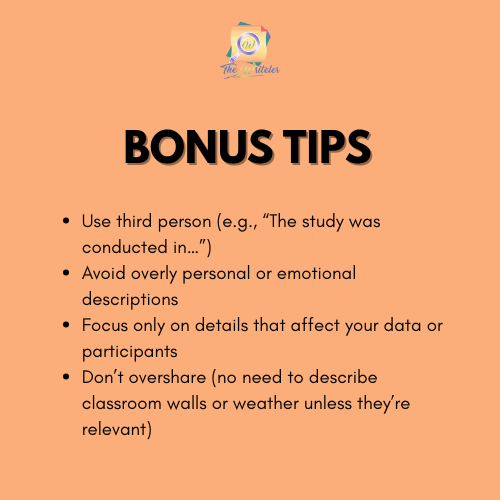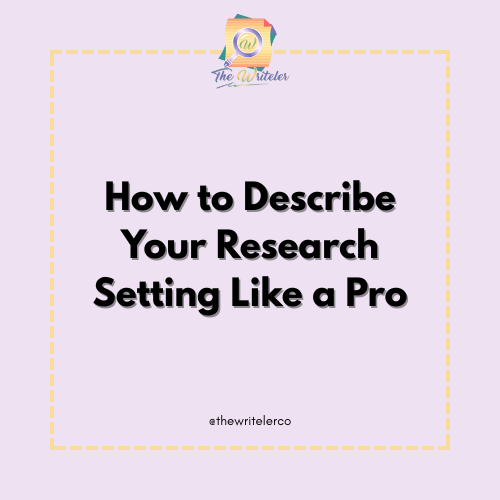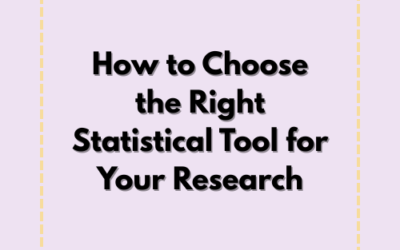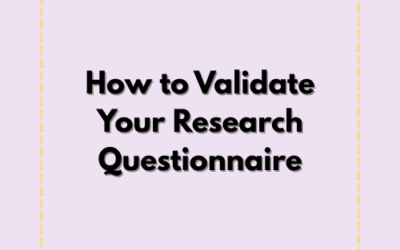When writing Chapter 3 of your thesis or dissertation, many students focus so much on instruments and sampling techniques that they overlook one important detail — the research setting.
Your research setting is where your study happens. It’s the space, physical or virtual, that gives context to your participants, procedures, and results. Describing it clearly and professionally helps your panel visualize your research and understand why your study fits within that specific environment.
In this blog, we’ll teach you how to write a strong research setting description — without overloading it with irrelevant details or sounding like a travel blogger.
What is a Research Setting?
A research setting refers to the specific place or platform where your study is conducted. This can be a physical location (like a school, office, or barangay), a virtual space (like Zoom, Google Forms, or social media), or a combination of both.
It’s important to describe it because:
- It adds credibility to your methodology.
- It shows that your research is grounded in a real-world context.
- It helps reviewers understand the scope and applicability of your findings.
What to Include in Your Description
To write your research setting like a pro, cover these four key elements:
✅ 1. Location
Start by naming the place(s) where your data was collected. Include:
- The name of the school, organization, or platform
- Its location (city/province/country)
- Type of institution (e.g., public/private, urban/rural, online/physical)
Example:
“The study was conducted at San Andres National High School, a public secondary school located in Tanay, Rizal.”
✅ 2. Population or Community Context
Give a brief background of the general population in the setting. Mention details relevant to your study, such as:
- Demographics (age group, income level, profession)
- Academic program or work setting
- Cultural, social, or economic context (if relevant)
“The school caters to approximately 1,500 students from Grades 7 to 12, most of whom come from low-income households in nearby barangays.”
✅ 3. Timeframe
Mention when the research was conducted. This adds relevance, especially if events like the pandemic or specific policies affected your data collection.
“Data gathering took place from February to March 2025, during the second semester of the academic year.”
✅ 4. Relevance to the Study
This is often overlooked, but very important. Explain why you chose this setting and how it relates to your research topic.
“This school was selected due to its early adoption of blended learning programs, which aligns with the study’s focus on digital literacy among senior high school students.”
Sample Research Setting Paragraphs
Here are examples you can model depending on your approach:
🧪 Quantitative Example:
“The research was conducted at Laguna Science High School, a public institution located in Sta. Cruz, Laguna. With a student population of around 1,200, the school implements various academic tracks including STEM, ABM, and HUMSS. The study focused on Grade 12 students under the STEM strand. Data collection occurred in March 2025, through printed surveys distributed during their homeroom period.”
💬 Qualitative Example:
“This study was carried out in Sitio Maligaya, a remote community in Northern Luzon. The setting was chosen for its limited access to mental health services, making it ideal for exploring residents’ experiences with traditional coping mechanisms. The research took place from April to May 2025, through in-depth interviews conducted in person.”
🌐 Online Example:
“The study was conducted entirely online using Google Forms to distribute surveys to participants from various higher education institutions in Metro Manila. The digital setting was appropriate given the ongoing distance learning setup during the academic year 2024–2025.”

Common Mistakes to Avoid
🚫 Writing too vaguely (“in a school” or “in our town”)
🚫 Including details that don’t add value (“the chairs were blue…”)
🚫 Forgetting to explain why the setting was chosen
🚫 Writing in first person (“I conducted the study at…”)
Always remember: The setting must support your research — not distract from it.
Final Thoughts
Describing your research setting might feel simple, but it’s a crucial part of your methodology. Done right, it sets the stage for your entire study and makes your research more understandable, reliable, and professional.
A well-written setting helps your readers visualize where your study takes place and understand why that location or platform is ideal for answering your research questions.
📣 Need Help Writing Chapter 3?
The Writeler Co. is here to support students and professionals who are juggling research with work, life, and business. Whether you’re writing a thesis, capstone, or dissertation for your master’s or Ph.D., we help you efficiently navigate the research journey — from brainstorming to proofreading.
📩 Message us today to get started.
📚 Let’s turn your research idea into a powerful paper.





0 Comments